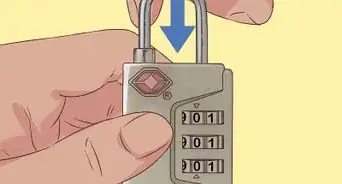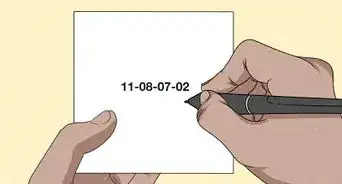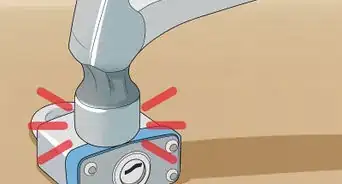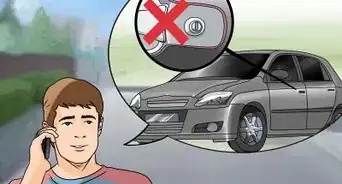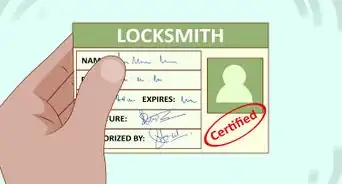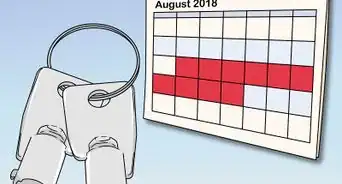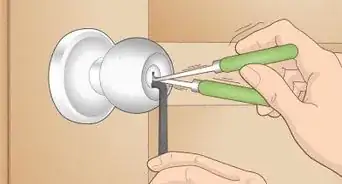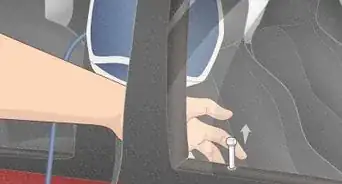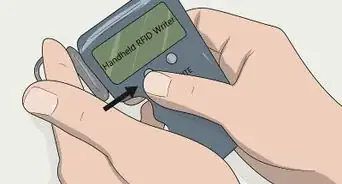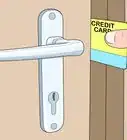This article was co-authored by Robert Vallelunga. Robert Vallelunga is a Locksmith and the Owner of ACME Locksmith in the Phoenix Metro Area. Robert has over 15 years of experience in the industry and specializes in working with automotive ignitions, locks, keys, and master key systems. Robert and the team at ACME are the #1 Rated Phoenix Locksmith Service and the Winner of the Better Business Bureau Ethics Award. Robert has his Residential & Commercial Contractor’s License and a Bachelor of Science in Electrical Engineering from Arizona State University.
This article has been viewed 2,281,174 times.
Door locks provide security and peace of mind, but they can also become quite irritating when they aren't working right, or if you accidentally leave your keys on the wrong side of one. Remember, before you start fiddling with picking locks and breaking down doors that you should really be sure you have no other options. Many of these methods take time to learn, so bear that in mind.
Steps
Using a Bump Key
-
1Bump open a tumbler lock. Bumping a lock is a quick, simple lock picking technique that is useful in the case of having to open a door that's been closed for a long time (for example, of an unused home on family property), or if you need to break into an elderly relative's house to make sure they're okay.[1]
- Bumping a lock does take some practice, and especially in the case of cheaper locks, it can damage the lock, so don't use it without a good reason.
-
2Acquire a bump key. A bump key is a key that will fit the lock you want to bump, but which doesn't unlock it per se. As long as the key will fit in the lock, it can be turned into a bump key by filing every cut down to the lowest acceptable depth.
- Most reputable locksmiths won't make a bump key for you, but you can sometimes find them online. To make one yourself, you'll need metalworking tools and some patience.
Advertisement -
3Fit the bump key into the lock-up to the last pin. Pin and tumbler locks are made of a round segment that turns once the pins inside line up and no longer blocks its motion. Every soft click you feel as you push a key into a lock is a pin being lifted by a tooth of the lock and then dropping onto the cut below it. Push your bump key in until there's one pin left that hasn't been lifted.
-
4Slam and turn the bump key. Use a small rubber mallet or similar object to strike the bump key hard, and turn it immediately thereafter. Since the pins inside the lock are in two sections, this slamming motion transfers force to the lower sections (which rest inside the tumbler), which then transfers it to the upper sections (which keep the tumbler from moving). If all the upper pin sections are lifted in this way, the lock will be able to turn.
- It may take a few tries to get the timing right, so keep at it until you're successful.
Using a Pick Set
-
1Pick a lock with a tension pick set. This is a specialized skill that takes a lot of practice and is normally only taught to bona fide locksmiths. The sale of tension pick sets is likewise restricted to people with proper credentials, but with some creativity, you can roughly approximate this tool on your own.
-
2Make your tools. For weak locks, a pair of paper clips should work; tougher locks might require bobby pins, wire clippers, and a pair of pliers. The key is to use metal firm enough for your pick and your tension wrench, the two components of the tool.
- Spring steel is the best material to use because it doesn't crack as easily and can be made with a file. You can get these from hacksaw blades. Consider the thickness of the blade because this will restrict the size of the locks that your lock pick will be able to enter.
- The tension wrench is made in an “L” shape and is used to apply tension to the bottom of the lock. You can make this by getting an Allen key and filing it flat.
- The pick itself is made with a much shorter leg, like a lowercase “r.” It's used to push pins out of the tumbler so it can rotate.
-
3Insert the tension wrench. Press it in along the bottom of the lock, and apply constant tension on it the whole time as you work with your pick. If you don't it will take longer and you may have to start again.
- If you're not entirely certain which direction which way to turn the tension wrench, put it in the lock and turn it one way. Pull out the pick quickly while listening closely to the lock. When you turn in the right direction, you'll actually hear the pins drop.
-
4Insert the pick above the wrench. Use the leg of the pick to find and push each pin up and out of the tumbler. Once all pins have been moved, the lock should open. As previously noted, this skill takes a lot of practice to master, so have plenty of cheap practice locks on hand if you hope to get good at it.
Using a Hex Wrench on an Interior Door
-
1Open interior doors with a hex wrench. Most interior locking doors made in the last few decades use a special type of doorknob that allows the door to be opened in the event of it being locked by accident. If your interior door handle has a small, round hole in the center, it is this type of handle.[2]
-
2Find or purchase a set of hex wrenches. Hexagonal or “hex” wrenches, also called “Allen wrenches,” are usually available for less than the cost of a fancy coffee at most hardware and home stores. They are small, L-shaped pieces of metal that come in an array of widths both metric and imperial.
-
3Fit the long end of a hex wrench into the hole on the door handle. You may have to try one or two different sizes to find the correct one, but it's usually fairly obvious. You want a fairly snug fit, but you shouldn't have to scrape or jam the wrench in. If you push the wrench in straight while turning it back and forth slightly, you should feel it catch on something.
-
4Turn the wrench to open the door. Once the wrench is fitted into the handle, a simple turn will unlock it. It shouldn't take a lot of force.
Using a Credit Card
-
1Open a simple lock with a credit card. This popular trick works less and less on modern doors, but is still a useful way to get into your house with older doors, should you leave without the keys.[3]
- Laminated cards tend to work the best. You want a card that is flexible (like a gift card) and one that you don't mind getting damaged. Sometimes you can damage your credit card enough so it won't work any longer.
-
2Put the credit card into the side of the door. Slide the long end of a credit card in between the door frame and the locking side of the door, just above where the lock enters the frame.
- Angle the card downward and situate it behind the bolt of the lock. You want to make sure that the card is perpendicular to the door.
-
3Slowly but firmly pull the card towards you while turning the handle. If you're lucky, the credit card will slide in between the beveled interior side of the bolt and the frame, and you'll be able to push the bolt all the way out of the frame by dragging the card towards you. The door will then open, as long as you keep the card in place between the bolt and the hole.
- Obviously, this trick will not work if the deadbolt has been set. Deadbolts don't have a beveled side. Fortunately, it's impossible to set your deadbolt from outside without your keys.
Jimmying a Car Door
-
1Jimmy a car door. Although “slim jims” (specialized metal tools for gaining entry to a locked car) are generally illegal, you can approximate the tool with a stiff metal coat hanger. If you've locked your keys in the car and a store or friend with coat hangers is close at hand, this can save you the hassle and waiting of calling a locksmith or roadside assistance service.
-
2Unravel and straighten the coat hanger. You can leave the hooked top section alone, but unwind it from itself at the “neck” and straighten the rest of the hanger out, giving you a long metal tool with a hooked tip.
-
3Lift the weather stripping from the bottom of the driver's-side window. Push the end of the hanger in through the soft rubber weather stripping and the bottom of the window. The hanger is now inside the wall of the door.[4]
-
4Scrape the hanger around and feel for a latch. The latch should be no more than a few inches below the window, near where the interior lock is.
-
5Hook and pull the latch. Hook the hanger around the latch and pull it towards the rear of the car. This should unlock any manually locked car door.
- If your door has a push-button electric unlocking mechanism, you can also slide the straight end of the hanger down from the top of the window instead, and use it like a finger to poke the button inside.
Using Brute Force
-
1Kick in a door. In an emergency situation, such as if you encounter someone's house on fire or your know of someone with a medical emergency who cannot answer the door, sometimes your only option is to physically force a door open. Be aware that this will ruin the door frame, the lock, and often the door itself. It's also physically dangerous compared to the other methods, so only attempt this if you are reasonably strong and in good physical shape.
- Stand in a solid stance. Squarely face the door with your feet roughly shoulder-width apart, knees slightly bent. If you can, brace your hands or arms against walls, furniture, or anything else that isn't likely to move when you shove it.
- Lift your dominant leg at the knee. Lift your knee straight up and let your lower leg be pulled along with it. Keep your foot facing the door. Don't turn sideways or do anything else fancy.
- Kick the lock on the door with the bottom of your foot. This type of kick is sometimes called a “snap kick.” Snap your leg straight out in front of you so that the flat of your foot strikes the door where the locking mechanism is set.
- It is safer to kick the door. Your feet are designed to absorb a great deal of force, and your shoes act as additional armor. DO NOT hit the door with your shoulder; you're more likely to dislocate it than you are to open the door.
- Continue kicking until the lock breaks from the frame. Given enough time, this will work on nearly any wooden door.
- If you don't begin to see results within a few minutes at most, it may be that the door or frame is reinforced. Rest and work in alternating periods so that your kicks don't become weak.
-
2Bust stubborn doors with a battering ram. If for some reason you'd prefer to use a battering ram on a stubborn door rather than simply calling a locksmith, a reasonably effective one can be made from a hand pile driver, the type used to drive posts into the ground.
- Purchase your manual pile driver. It should be a few feet long, with longish handles on either side.
- Fill the driver all or partway with cement. Be sure to let the cement dry completely before using.
- Use a side-tossing motion to drive the ram into the door at the lock mechanism. Swing the ram back across the front of your body with both hands as you stand perpendicular to the door, then lean and strike towards the door with the ram. Most doors should break within a few hits.
- Bear in mind that the door will in all likelihood be completely ruined and require a replacement.
Community Q&A
-
QuestionHow do I open a door without creating damage?
 Community AnswerCredit cards do not cause damage though that only works without deadbolts. Slide the card in between the frame and the door where handle is and apply pressure until you hear a pop and door will swing open.
Community AnswerCredit cards do not cause damage though that only works without deadbolts. Slide the card in between the frame and the door where handle is and apply pressure until you hear a pop and door will swing open. -
QuestionMy closet door is locked from the inside. How do I open it?
 Community AnswerYou can use some of the methods listed here. The easiest one for a closet door would be to use the credit card method.
Community AnswerYou can use some of the methods listed here. The easiest one for a closet door would be to use the credit card method. -
QuestionWhat can I do if I don't have a credit card?
 Community AnswerYou can use any card of similar size and material. It's often better not to use a credit card, since it is more valuable than other cards. If it is bent, you may have to get a new one. Try to use old gift cards or any other less valuable cards.
Community AnswerYou can use any card of similar size and material. It's often better not to use a credit card, since it is more valuable than other cards. If it is bent, you may have to get a new one. Try to use old gift cards or any other less valuable cards.
Warnings
- Don't try to break down a door with your shoulder. It only works in the movies.⧼thumbs_response⧽
- If you're locked out of a rental property, call the groundskeeper, manager, or landlord before you try to break in. Chances are, one of them will have a key that they can use to open your home for you, and breaking into a rental property can be legally ambiguous, especially if you cause property damage.⧼thumbs_response⧽
- Don't try to shoot locks off of anything. It's much more likely to result in a potentially lethal ricochet than anything else. You could also irreparably jam the lock into a secure position, thanks to the dent you're likely to create.⧼thumbs_response⧽
- Breaking into anything that isn't yours is invasive and highly illegal. Don't do it.⧼thumbs_response⧽
- In some places, carrying lock picking equipment without proof that you're a locksmith is also illegal.[5] Depending on the mood of the officer arresting you, this could include homemade equipment. Don't use such items unless you absolutely need to.⧼thumbs_response⧽
References
- ↑ http://www.snopes.com/crime/warnings/bumpkeys.asp
- ↑ http://home-tools.wonderhowto.com/how-to/open-locked-bedroom-bathroom-door-423788/
- ↑ https://www.thelondonlocksmiths.co.uk/locksmith-services/how-to-open-a-locked-interior-door-when-youve-lost-the-key/
- ↑ https://wheelzine.com/how-to-use-slim-jim-to-unlock-car-door-if-you-lose-your-keys
- ↑ https://tihk.co/blogs/news/116232133-lock-pick-legality
About This Article
To open a locked door without a key, first see if the lock is a spring lock. A spring lock is slanted and is part of the handle. If it is, slide a credit card you don’t mind damaging between the lock and the door frame. Bend the card back towards the frame to force the lock into the door. If there’s no room between the lock and frame, slide the card in the space above the lock and between the door and the frame. Angle the card towards the frame. Then, swipe quickly downward. To open a locked interior door with a screwdriver, first push the screwdriver as far as you can into the hole on the doorknob. Then, just turn and twist until the screwdriver catches on a groove and the lock clicks open. This method will also work with a flattened paperclip or a very small butter knife. If you want to learn more, like how to pick the lock or use a bump key, keep reading the article!
